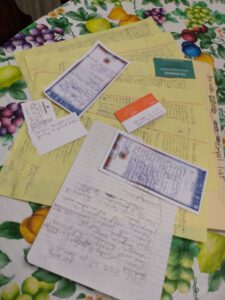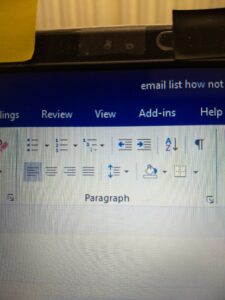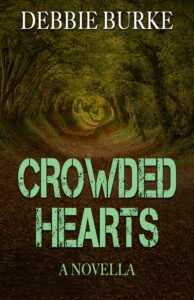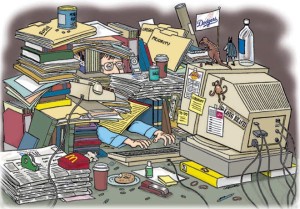By Debbie Burke
A good, solid email list is the cornerstone for marketing books.
Why?
Those names are customers and potential customers who may buy your books.
As a business owner in the 1980s, I managed lists of more than a thousand customers and vendors. Using my trusty Kaypro 10, I knew how to create, organize, and keep those lists up to date.
But, as a 21st century author, did I apply those same principles to building a list of readers?
Uh, no. (Hangs head in shame)
Instead, I collected business cards and scribbled names on yellow legal pads and scratch paper. I threw them in a folder without any logic or organization.
Alphabetize? I’ll get around to it one of these days (hah!).
Imagine looking for a particular name when the order on the page read: Helen, Laura, Roger, Holly, Barb, Eli, etc. Talk about wasting time.
If I’d maintained a sloppy customer list like this (see photo) in business, I’d have fired me.
My writing career should have been treated as a business, not a muddled jumble. I knew such tasks needed to be done but always put them off because I’d rather write.
After publishing five books, I finally decided to create an organized, alphabetized Master Email List.
If you haven’t published a book yet, start building your list now because you will need it in the future.
The rest of you pros with published books already have your master email list, right?
Below are 10 items I SHOULD have done and didn’t. Or DID and shouldn’t have. Don’t follow my bad example.
Best practices and worst practices to build an email list:
1st – Good practice: collect business cards from people at conferences, classes, workshops, book club meetings, etc.
Today, with virtual events on Zoom, collect names and emails from the chat box of participants.
Bad practice: put those cards in a drawer and forget about them.
2nd – Good: at book appearances or discussions, always have a sign-up sheet for attendees’ names and email addresses. With Zoom, log names and emails of registrants and add to your Master List.
Bad: stick those sheets in a file and forget about them (see a pattern here?).
3rd – Good: when launching a new book, send announcements to everyone on your email list.
Bad: your list consists of names and emails scrawled on cocktail napkins, yellow legal pads, scrap paper, backs of envelopes, and the palm of your hand.
4th – Good: type your entire email list in a Word file or Excel spreadsheet. Alphabetize and number it.
 Sidebar: how to alphabetize in Word. After years of using Word to write, I just learned this handy tip. To alphabetize, go to Home, go to Paragraph box, find A-Z. Click on that icon and a window opens (see photo). Click Sort by Paragraph, choose text, ascending, then click okay.
Sidebar: how to alphabetize in Word. After years of using Word to write, I just learned this handy tip. To alphabetize, go to Home, go to Paragraph box, find A-Z. Click on that icon and a window opens (see photo). Click Sort by Paragraph, choose text, ascending, then click okay.
Voila, the names are alphabetized so you can easily locate them. Big time saver.
If you use Excel, here are instructions about how to alphabetize.
Alphabetize either by first name or last name, although last name is most common. Mine is alphabetized by first name because that’s how I remember people. Often I never know the last name of casual acquaintances.
However, first names can be a bit confusing. My list includes 5 Anns or Annes; 6 Barbaras (Barb, Babs); 7 Janets or Janices; 5 Karens; 10 variations on Catherine-Kathryn (Cathy, Katie, etc.); 6 Pats (Patrick or Patricia); 8 variations of Susan (Sue, Suzanne, Susie, etc.); 6 Terrys (male and female).
First names work fine for me but you may prefer to alphabetize by last names.
Use the method that’s easiest for you to track.
5th – Good: make a notation where you met the person, e.g. writing conference, book club, library appearance, etc. That helps when you want to tailor a specific message to a specific group (“Dear Book Club Friends”, “Dear Zumba Buddies”, etc.).
If you use Excel, enter those notations in their own column.
With Word, just tab to a blank space and make a note where you met.
Again, use the method that works best for you.
Bad: Depend on your memory. Was that “Jeff” from the continuing ed class or “Jeff” from sophomore year? Doesn’t work—trust me.
6th – Good: create subcategories within the main list, e.g. book club contacts, conference contacts, coworkers, writing colleagues, friends and family, old school buddies, etc.
Bad: Same caution about memory in #5.
7th – Good: tailor the message to each category. In other words, write in a different tone to coworkers than to your pals from high school.
Bad: send out an impersonal, mass email blast that smells like spam.
Special note: For critique buddies, beta readers, researchers, and consultants, always send a thank you message for their assistance and a gift copy of the book.
8th – Good: organize the Master List by name.
Bad: Organize the list by email address. In many cases, the email address gives no clue to the person’s name and the “search” function may not help you find who the address belongs to.
For instance, when I wanted to contact an old friend, Barry, I couldn’t locate him because his email handle is “Azuki,” which I didn’t remember.
Or worse, who the heck is “rawkiwi@xxx.com” and why didn’t I record his/her name? After serious digging through piles of paper, it turned out I’d met her at a bookstore signing two years ago. Her name was “Trish” and she’d specifically asked to be notified when new books are released—definitely someone who should be included on the Master List.
9th – Good: add new names and emails as soon as you receive them.
Bad: wait to update your list until you collect a big batch of names. If you don’t add them right away, you may lose the contact. Take, for example, the woman I met in the supermarket who loves thrillers and scrawled her email address on my grocery list…which ended up in the trash, gone forever. (Sigh)
10th – Good: Update changes to email addresses immediately and delete the old.
Bad: keep outdated email addresses so you’re guaranteed lots of bounce-backs.
Miscellaneous helpful hints:
How to number in Word: in Home, go to paragraph box, choose numbered list (see photo).
Now you know exactly how many people are on your email list. You may be pleasantly surprised that it’s more than you expected.
How to number in Excel: here are instructions.
Caution: The contact list in your computer or phone does not necessarily include everyone who should be on your Master List.
For Gmail, use their prompt system. Click on “Compose” and type the first few letters of a name. If you’ve ever sent or received an email using those initial letters, a drop-down list of names appears, up to six or seven choices.
Among those may be names you’ve forgotten about. That’s how I’ve caught many people who don’t appear in my contacts but should be on the master list.
Other email servers, like Yahoo, MSN, and Hot Mail, may also have ways to prompt but I’m not familiar with them. TKZers, if you know, please chime in.
The best practice of all:
No matter what system you use (Word, Excel, etc.), create your Master Email List in the format you’re most likely to keep up-to-date.
~~~
In 2017, when my first thriller (Instrument of the Devil) was published, I sent out about 100 announcements.
Today, with five books published, my newly-organized email list numbers more than 300.
It took almost three days of concentrated effort to unsnarl my previous sloppiness. How much easier would the task have been if I’d properly set up the list back in 2017 then added to it?
Now that my Master List is done, adding a name/email address is a simple matter of opening that Word file and entering changes—takes 30 seconds.
Learn from my mistakes.
Start your Master Email List off on the right foot.
~~~
TKZers: Do you have a Master Email List?
What are your favorite tricks to keep the list organized?
~~~
Debbie Burke’s new novella, Crowded Hearts, is not a typical wedding story. Available FREE from October 13-17, 2020. Please check out the link here.




